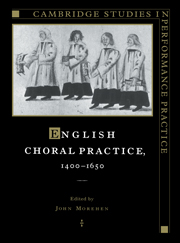Book contents
- Frontmatter
- Contents
- List of plates
- General preface
- Preface
- Abbreviations
- 1 To chorus from quartet: the performing resource for English church polyphony, c. 1390–1559
- 2 Editing and performing musica speculativa
- 3 The sound of Latin in England before and after the Reformation
- 4 English pronunciation, c. 1500 – c. 1625
- 5 Byrd, Tallis and Ferrabosco
- 6 John Baldwin and changing concepts of text underlay
- 7 Sacred songs in the chamber
- 8 The education of choristers in England during the sixteenth century
- 9 The ‘burden of proof’: the editor as detective
- Index of names and places
- Index of manuscript and printed music sources
- Index of works cited
5 - Byrd, Tallis and Ferrabosco
Published online by Cambridge University Press: 03 March 2010
- Frontmatter
- Contents
- List of plates
- General preface
- Preface
- Abbreviations
- 1 To chorus from quartet: the performing resource for English church polyphony, c. 1390–1559
- 2 Editing and performing musica speculativa
- 3 The sound of Latin in England before and after the Reformation
- 4 English pronunciation, c. 1500 – c. 1625
- 5 Byrd, Tallis and Ferrabosco
- 6 John Baldwin and changing concepts of text underlay
- 7 Sacred songs in the chamber
- 8 The education of choristers in England during the sixteenth century
- 9 The ‘burden of proof’: the editor as detective
- Index of names and places
- Index of manuscript and printed music sources
- Index of works cited
Summary
I remember many years ago reading an article in an American newsletter devoted to computer-aided textual criticism and analysis in the Greek and Latin classics. The details are vague now, but the author s main point sticks vividly in the mind: it was a somewhat plaintive question as to whether we, commanding sophisticated gadgetry, are any more appreciative of Vergil than those nineteenth-century amateurs who relied simply on a few pencilled marginal notes. Telephones do not breed good conversationalists, nor do word-processors engender stylists; but there is a happy belief that computers can somehow convert base instructions into conclusions of gold. The sentiments of that half-forgotten article are thus still germane fifteen or so years later, when understanding has by no means kept pace with verbiage.
There are exceptions, however: as John Morehen has shown by asking the right questions problems of authenticity can be greatly illumined, even solved, by computer methods. Penelope Rapson demonstrated that seemingly intractable problems of textual criticism and stemmatics can be side-stepped by algorithms. And in a previous article I reported the late John Duffill's work on the question of pitch in Byrd's church music. There, unfortunately, his statistics could not be properly presented, and the article had to be truncated in several other ways, notably in regard to a discussion of aspects of Ferrabosco s influence on Byrd. These omissions are made good here, and Duffill's more recent statistics concerning the elder Ferrabosco have been included. For the sake of intelligibility, some of the findings of the previous article are repeated here.
- Type
- Chapter
- Information
- English Choral Practice, 1400–1650 , pp. 109 - 142Publisher: Cambridge University PressPrint publication year: 1996



